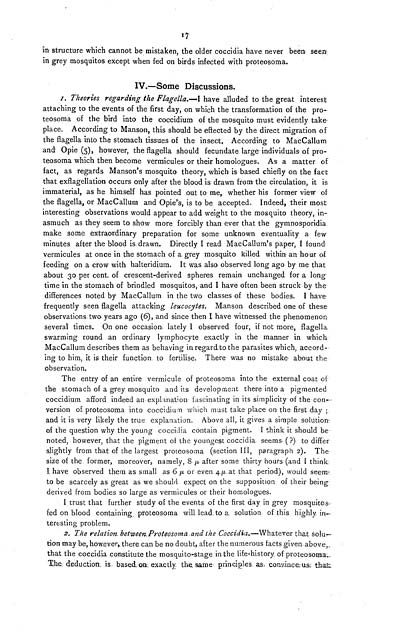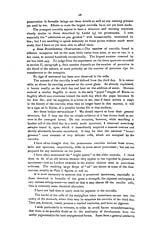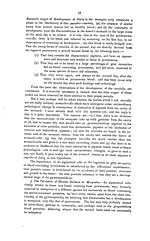Medicine - Disease > Report on the cultivation of protesoma, Labbé, in grey mosquitoes
(25) Page 17 - IV - Some discussions
Download files
Individual page:
Thumbnail gallery: Grid view | List view

17
in structure which cannot be mistaken, the older coccidia have never been seen
in grey mosquitos except when fed on birds infected with proteosoma.
IV.-Some Discussions.
I. Theories regarding the Flagella.-I have alluded to the great interest
attaching to the events of the first day, on which the transformation of the pro-
teosoma of the bird into the coccidium of the mosquito must evidently take-
place. According to Manson, this should be effected by the direct migration of
the flagella into the stomach tissues of the insect, According to MacCallum
and Opie (5), however, the flagella should fecundate large individuals of pro-
teosoma which then become vermicules or their homologues. As a matter of
fact, as regards Manson's mosquito theory, which is based chiefly on the fact
that exflagellation occurs only after the blood is drawn from the circulation, it is
immaterial, as he himself has pointed out to me, whether his former view of
the flagella, or MacCallum and Opie's, is to be accepted. Indeed, their most
interesting observations would appear to add weight to the mosquito theory, in-
asmuch as they seem to show more forcibly than ever that the gymnosporidia
make some extraordinary preparation for some unknown eventuality a few
minutes after the blood is drawn. Directly I read MacCallum's paper, I found
vermicules at once in the stomach of a grey mosquito killed within an hour of
feeding on a crow with halteridium. It was also observed long ago by me that
about 30 per cent. of crescent-derived spheres remain unchanged for a long
time in the stomach of brindled mosquitos, and I have often been struck by the
differences noted by MacCallum in the two classes of these bodies. I have
frequently seen flagella attacking leucocytes. Manson described one of these
observations two years ago (6), and since then I have witnessed the phenomenon
several times. On one occasion lately I observed four, if not more, flagella
swarming round an ordinary lymphocyte exactly in the manner in which
MacCallum describes them as behaving in regardto the parasites which, accord-
ing to him, it is their function to fertilise. There was no mistake about the
observation.
The entry of an entire vermicule of proteosoma into the external coat of
the stomach of a grey mosquito and its development there into a pigmented
coccidium afford indeed an explanation fascinating in its simplicity of the con-
version of proteosoma into coccidium which must take place on the first day;
and it is very likely the true explanation. Above all, it gives a simple solution
of the question why the young coccidia contain pigment. I think it should be
noted, however, that the pigment of the youngest coccidia seems (?) to differ
slightly from that of the largest proteosoma (section III, paragraph 2). The
size of the former, moreover, namely, 8 after some thirty hours (and I think
I have observed them as small as 6 or even 4 at that period), would seem
to be scarcely as great as we should expect on the supposition of their being
derived from bodies so large as vermicules or their homologues.
I trust that further study of the events of the first day in grey mosquitos
fed on blood containing proteosoma will lead to a solution of this highly in-
teresting problem.
2. The relation between Proteosoma and the Coccidia.-Whatever that solu-
tion may be, however, there can be no doubt, after the numerous facts given above,
that the coccidia constitute the mosquito-stage in the life history of proteosoma.
The deduction is based on exactly the same principles as convince us that
in structure which cannot be mistaken, the older coccidia have never been seen
in grey mosquitos except when fed on birds infected with proteosoma.
IV.-Some Discussions.
I. Theories regarding the Flagella.-I have alluded to the great interest
attaching to the events of the first day, on which the transformation of the pro-
teosoma of the bird into the coccidium of the mosquito must evidently take-
place. According to Manson, this should be effected by the direct migration of
the flagella into the stomach tissues of the insect, According to MacCallum
and Opie (5), however, the flagella should fecundate large individuals of pro-
teosoma which then become vermicules or their homologues. As a matter of
fact, as regards Manson's mosquito theory, which is based chiefly on the fact
that exflagellation occurs only after the blood is drawn from the circulation, it is
immaterial, as he himself has pointed out to me, whether his former view of
the flagella, or MacCallum and Opie's, is to be accepted. Indeed, their most
interesting observations would appear to add weight to the mosquito theory, in-
asmuch as they seem to show more forcibly than ever that the gymnosporidia
make some extraordinary preparation for some unknown eventuality a few
minutes after the blood is drawn. Directly I read MacCallum's paper, I found
vermicules at once in the stomach of a grey mosquito killed within an hour of
feeding on a crow with halteridium. It was also observed long ago by me that
about 30 per cent. of crescent-derived spheres remain unchanged for a long
time in the stomach of brindled mosquitos, and I have often been struck by the
differences noted by MacCallum in the two classes of these bodies. I have
frequently seen flagella attacking leucocytes. Manson described one of these
observations two years ago (6), and since then I have witnessed the phenomenon
several times. On one occasion lately I observed four, if not more, flagella
swarming round an ordinary lymphocyte exactly in the manner in which
MacCallum describes them as behaving in regardto the parasites which, accord-
ing to him, it is their function to fertilise. There was no mistake about the
observation.
The entry of an entire vermicule of proteosoma into the external coat of
the stomach of a grey mosquito and its development there into a pigmented
coccidium afford indeed an explanation fascinating in its simplicity of the con-
version of proteosoma into coccidium which must take place on the first day;
and it is very likely the true explanation. Above all, it gives a simple solution
of the question why the young coccidia contain pigment. I think it should be
noted, however, that the pigment of the youngest coccidia seems (?) to differ
slightly from that of the largest proteosoma (section III, paragraph 2). The
size of the former, moreover, namely, 8 after some thirty hours (and I think
I have observed them as small as 6 or even 4 at that period), would seem
to be scarcely as great as we should expect on the supposition of their being
derived from bodies so large as vermicules or their homologues.
I trust that further study of the events of the first day in grey mosquitos
fed on blood containing proteosoma will lead to a solution of this highly in-
teresting problem.
2. The relation between Proteosoma and the Coccidia.-Whatever that solu-
tion may be, however, there can be no doubt, after the numerous facts given above,
that the coccidia constitute the mosquito-stage in the life history of proteosoma.
The deduction is based on exactly the same principles as convince us that
Set display mode to: Large image | Zoom image | Transcription
Images and transcriptions on this page, including medium image downloads, may be used under the Creative Commons Attribution 4.0 International Licence unless otherwise stated. ![]()
| India Papers > Medicine - Disease > Report on the cultivation of protesoma, Labbé, in grey mosquitoes > (25) Page 17 - IV - Some discussions |
|---|
| Permanent URL | https://digital.nls.uk/74580866 |
|---|




